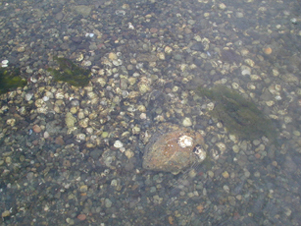
Animals move for various needs involved
in feeding, reproduction, and protection. Because there are no completely
pelagic organisms at Argyle, we will
concentrate on the challenges of locomotion over a substrate.
The substrate at Argyle varies in its composition, including combinations
of boulders, large smooth pebble, coarse pebble, sand, anoxic mud, other
mud and clay, dead clam and barnacle shells, and live oyster and barnacle
shells. Locomotion over a substrate is not limited to a two-dimensional
surface, as rocks and sediment create structure and permit vertical movement.
In Argyle, we defined substrates by their position on rock surfaces: epifaunal,
cryptofaunal, and infaunal.
We then used these designations to survey the diversity and
distribution of different organisms.

Different modes of locomotion (or the absence of locomotion) can be identified for animals at Argyle Creek:

SESSILE ORGANISMS
Given the high velocity flow environment
of Argyle Creek, many animals are sessile. The diversity of organisms that
are sessile span five phyla, including
sponges, bryozoans, arthropod barnacles, annelid tube worms, and molluscan
oysters. Sessile organisms cement themselves onto substrates such
as rocks, or other organisms, as is the case with bryozoans and sponges
that can grow over the shells of barnacles and oysters. The choices
that sessile organisms make at the time of settlement are extremely important,
because they will only ever interact--in terms of feeding, reproduction,
and protection--with their immediate environment, and with water that flows
past that particular location.
Influx of ocean water provides food
for filter feeders, along with a means of waste
removal, gas exchange and gamete dispersal.
Many sessile adults have planktonic
larvae, such as barnacle nauplii, which swim using setose appendages and
choose, with sensory input, the substratum to which the adult is permanently
attached.

SEMI-SESSILE ORGANISMS
Semi-sessile
organisms, like the dark shelled mussel Mytilus pictured to the
left, are temporarily attached to a substrate, but have the ability to
detach and reattach. Mussels continually produce and dissolve byssal
threads from a specialized gland on the foot, which they use to attach
to a hard substrate, sometimes another mussel. Unlike rocky intertidal
mussels, which aggregate attached to rocks, mussels at Argyle were found
to form large mats with small rocks tied together by byssal threads, similar
to mussels found in bays. Mats could be lifted intact from the pebble
surface, which were held in place by the weight of the mat.
Anemones can crawl or drop from their
substrate, and reattach elsewhere. Evidence of this comes from our
observation that certain sessile organisms typically found on the top of
rocks, such as barnacles, occasionally were found inappropriately on the
underside of rocks, suggesting that the rock had been turned over.
Small (0.25 cm to 1.0 cm) orange anemones, on the other hand, were nearly
always on the underside, suggesting that the anemones had moved consistently
in response to rock turning.
BURROWERS
Burrowing organisms include bivalve
clams, gastropod snails, annelid worms, and echinoderm brittle stars, which
all use different methods to burrow. Clams burrow using a muscular
foot, which is expanded through the application of hydraulic pressure to
a fluid filled cavity called a hemocoel. The burrowing process occurs
as follows: the siphons close to prevent sediment from entering the mantle
cavity, and the foot probes downward. Pressure is then increased
in the hemocoel, creating a "terminal anchor," or bulge at the tip of the
foot. With the foot wedged into place, retractor muscles then pull
the shell downward. The adductor muscles holding the shell closed
then relax, allowing the shell to open and to remain anchored in the sediment.
This burrowing cycle is then repeated.
Small, tall-spired gastropods, Bittium
eschrichtii, were predominantly found in the sediment of Zone 1, where
they burrowed using the muscular foot. Their shells were found downstream
from this site, primarily as "shell hash" and as homes adopted by small
hermit crabs. We found small brittle stars (Amphipholis squamata,
measuring 1 cm arm tip to arm tip) both cryptofaunally and in the sediment
below surface rocks, where arms appear to operate in burrowing, by scraping
out a hole while other appendages afford anchorage or propel the animal
forward.
CREEPERS
Animals that use creeping locomotion,
involving mucous and muscular contractions, include various molluscs (limpets,
chitons, gastropod snails, and nudibranchs). The muscular foot uses
hydrostatic pressure of the hemocoel to produce waves of expansion, contraction,
and contact between the mucous-coated foot and the substrate. Animals
can move using "retrograde" waves or "direct" waves of contraction, where
the wave moves either opposite to or in the same direction as the movement
of the animal, respectively. The two sides of the limpet foot can
be controlled independently, so that waves can move in opposite directions
on either half of the foot, allowing the animal to turn around without
moving forward.
WALKERS AND SWIMMERS
Crabs walk sideways using their jointed
thoracic appendages as levers by both extending, which pushes the body
off the substrate, and retracting, which pulls the body in the direction
of motion. Two species of crabs were observed, and these species
moved over different spatial scales, related to crab size. Hemigrapsus
(2 cm) were found walking on, between, and under small (2-3 cm) pebbles.
The larger crabs (Cancer magister), found strictly in zone
4, covered much larger distances, walking over larger parts of the substratum
over several meters.
Swimming was used by sculpin fish,
which swam in the water column hovering above the substrate.
 |
 |
|
|
|
References: